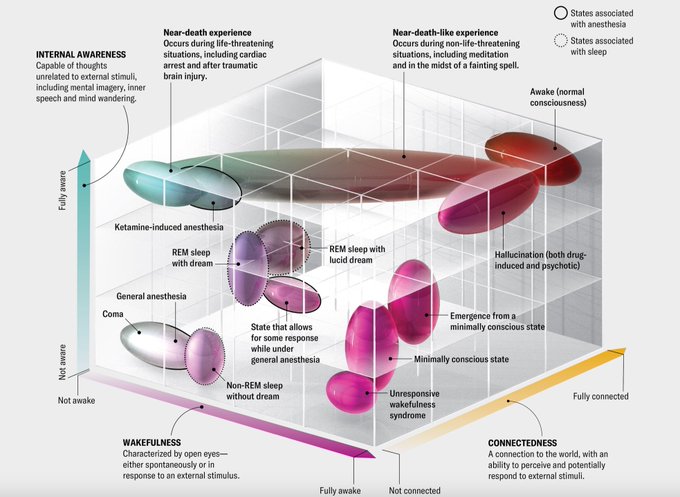BEINGON Institute
for ADVANCED FREE WILL


BrainStorms
Digital Rolodex of related organizations, persons, resources.
What are the three types of neuroscience?
Links
Perception
QUALIA RESEARCH INSTITUTE
◊ ~ https://qri.org/
Building a New Science of Consciousness
Develop a precise mathematical language for describing subjective experience
Understand the nature of emotional valence (happiness and suffering)
Map out the full space of possible conscious experiences
Build technologies to improve the lives of sentient beings
QUALIA COMPUTING
◊ ~ https://qualiacomputing.com/
In brief, epiphenomenalism cannot be true *{ the view that mental events are caused by physical events in the brain, but have no effects upon any physical events}
Qualia, it turns out, must have a causally relevant role in forward-propelled organisms, for otherwise natural selection would have had no way of recruiting it.
I propose that the reason why consciousness was recruited by natural selection is found in the tremendous computational power that it afforded to the real-time world simulations it instantiates through the use of the nervous system. More so, the specific computational horse-power of consciousness is phenomenal binding –the ontological union of disparate pieces of information by becoming part of a unitary conscious experience that synchronically embeds spaciotemporal structure. While phenomenal binding is regarded as a mere epiphenomenon (or even as a totally unreal non-happening) by some, one needs only look at cases where phenomenal binding (partially) breaks down to see its role in determining animal behavior.
Once we recognize the computational role of consciousness, and the causal network that links it to behavior, a new era will begin. We will (1) characterize the various values of qualia in terms of their computational properties, and (2) systematically explore the state-space of possible conscious experiences.
(1) will enable us to recruit the new qualia varieties we discover thanks to (2) so as to improve the capabilities of our minds. This increased cognitive power will enable us to do (2) more efficiently. This positive-feedback loop is perhaps the most important game-changer in the evolution of consciousness in the cosmos.
We will go from cognitive sciences to actual consciousness engineering. And then, nothing will ever feel the same.
Anil Seth
Anil Kumar Seth is a British neuroscientist and professor of Cognitive and Computational Neuroscience at the University of Sussex. A proponent of materialist explanations of consciousness, he is currently amongst the most cited scholars on the topics of neuroscience and cognitive science globally.
Dr. Anna CIAUNICA
◊ ~ @AnnaCiaunica
I’m a Principal Investigator working on self-consciousness, embodiment and social interactions in Humans and Artificial Agents
I’m currently based at the Centre for Philosophy of Science, Faculty of Science, University of Lisbon, Portugal; and at the Institute of Cognitive Neuroscience, University College London, the UK – the Social Neuroscience Group.
I specifically aim to investigate:
- what is self-consciousness and how it develops in relation to our body and our physical and social environment
- the effect of interacting with humans versus artificial others (robots, Virtual Reality characters and Artificial Intelligence) on the human mind and body.
To this end, I use conceptual and psychophysiological methods, together with behavioural testing and advanced neuroimaging techniques (fNIRS) to map changes in behaviour, phenomenology, and brain when people interact with humans versus artificial others in natural and in virtual environments.
I’m currently PI on three interdisciplinary projects looking at multisensory processing of the self and other in people that feel detached from their self, body and the world.
Donald Hoffman
◊ ~ https://x.com/donalddhoffman
◊ ~ https://sites.socsci.uci.edu/~ddhoff/
What does Donald Hoffman say about reality?
Hoffman proposes a solution to the hard problem of consciousness by adopting the converse view that consciousness causes brain activity and, in fact, creates all objects and properties of the physical world. To this end, Hoffman has developed and combined two theories: the “multimodal user interface” (MUI) theory of perception and “conscious realism”.
David Eagleman
◊ ~ David Eagleman (@davideagleman) / X
David Eagleman is an American neuroscientist, author, and science communicator. He teaches neuroscience at Stanford University and is CEO and co-founder of Neosensory, a company that develops devices for sensory substitution.
Sheila L. Macrine, PhD.
◊ ~ https://embodiedcognitionandlearning.com/sheila-macrine-phd/
Sheila Landers Macrine, PhD, is a Professor, a Cognitive Scientist and Psychologist. Her expertise includes embodied cognition, cognitive development, alternative assessment, and the learning sciences. Her work has challenged traditional approaches to learning and assessment, including developing alternative IQ testing, developing assessments for students from culturally diverse backgrounds, students with intellectual disabilities, and those with learning differences. She recently published papers on Embodied Cognition in Frontiers, the International Journal of School and Educational Psychology, and in the Oxford Research Encyclopedias-Education at Oxford University Press. She is also a critical feminist who has published numerous articles and books. She completed two Ph.D.’s in Cognition Psychology and School Psychology at Temple University. Her current book with Professor Jennifer Fugate, “Movement Matters: How Embodied Cognition Informs Teaching and Learning” is published by MIT Press.
Sheila is currently a Full Professor in the Department of STEM Education and Teacher Development at the University of Massachusetts Dartmouth where she coordinates the Special Education Program. Her teaching and mentoring have been recognized with the Kappa Delta Excellence in Teaching & Advising Award.
Jennifer M.B. Fugate, PhD.
◊ ~ https://embodiedcognitionandlearning.com/jennifer-fugate-phd/
Dr. Jennifer Fugate is a world-wide expert of emotion theory and perception, trained in the cognitive underpinnings of how people construct emotion through their language. She is the author of numerous empirical and theoretical pieces on the role of language in emotion, as well as a certified Facial Action Coder. She received her PhD from Emory University in Comparative Social Cognition, completing two postdocs in human emotion with the renowned psychologist and author, Lisa Feldman Barrett at Northeastern University. Dr. Fugate received tenure and promotion at the University of Massachusetts Dartmouth, where she worked for nine years. During this time, her work was featured in Malcolm Gladwell’s book, Talking to Strangers. She was awarded Scholar of the Year in 2019.
Dr. Fugate is now (January, 2022) an Associate Professor in Psychology at Kansas City University and directs the ABLE (affective, behavior, learning and embodiment) lab for able mind and body.
Links
Perception Tech
NETRI
◊ ~ https://netri.com/#Pain-program
Neurons as a sensor: the concept
Human neurons transport information in the human body, processing complex signals in the Central Nervous System (CNS) and relaying data via the Peripheral Nervous System (PNS). Acting as natural machines, they integrate biological information and transform it into digital signals. Sensory neurons, located in the spinal column, innervate organs and send continuous feedback on their state (healthy, damaged, or abnormal). This data is encoded by action potentials transmitted to the CNS.
Since 2018, NETRI has leveraged this natural process to digitize biology. It develops organs-on-chip using human neural stem cells to reproduce innervation, record neural data (digital signatures), and decode it with AI algorithms. By applying compounds or fluids to nerve endings, NETRI predicts efficacy, toxicity, and diagnoses by comparing signatures in digital libraries.
Suzanne Gildert :: Nirvanic
◊ ~ https://www.suzannegildert.com/
◊ ~ https://x.com/suzannegildert
◊ ~ https://nirvanicai.substack.com/
Suzanne Gildert
Suzanne is obsessed with understanding consciousness. She is the CEO-founder of Nirvanic Consciousness Technologies, a quantum-AI technology company innovating “Conscious AI” for improved AI decision-making. Suzanne is a prolific technology inventor with dozens of US patents in quantum computing and AI robotics. She previously co-founded Sanctuary AI — building human-like intelligence in General Purpose Robots — and Kindred AI, developing industrial-AI robotics. The acquisition of Kindred AI by Ocado in 2020 for one third of a billion dollars ($339 million CAD) was the third-largest exit for a robotics company in Canadian history.
Suzanne has deep expertise in quantum computing from her time at D-Wave where she ported AI algorithms to D-Wave’s quantum annealing hardware. She created quantum algorithms for D-Wave customers including NASA and Lockheed Martin, developed quantum machine learning algorithms for training neural networks and classifiers, and pioneered an online cloud service for quantum application developers.
Suzanne holds a Ph.D. in experimental quantum physics from the University of Birmingham in the UK, near her hometown of Bolton. She is also a published digital artist and painter.
Nirvanic
Conscious AI
Nirvanic is testing a model of quantum conscious agency with widespread application for artificial intelligence.
We aim to humanize and improve the safety of AI.
Nirvanic believes there’s much to be learned from natural, biological intelligence to improve future AI systems. Today’s silicon-based digital AI systems, we believe, are not conscious.
All life employs some level of consciousness to assess countless sensory inputs and make rapid decisions about exploration, attention and survival. We are testing if quantum fields conjectured to be operating in neural biology can be applied to a new type of Conscious AI using a non-biological alternative — quantum computers. We postulate that properties found in quantum physics — superposition, entanglement and quantum measurement — map well to conscious experience.
If we are correct, we can unlock a new kind of AI consciousness with the safety traits necessary for working in harmony with people: intuition, empathy, judgment, nuanced reasoning and morality.
At Nirvanic, we see consciousness research as the next big quantum use case.
Links
BCI
Brain-Computer Interface (BCI) Society
◊ – Brain-Computer Interface (BCI) Society site: https://bcisociety.org/about/
The Brain-Computer Interface (BCI) Society is a member driven organization with 300+ members located in over 24 countries around the world. The BCI Society was formally established on March 13, 2015 as an international organization that is legally based in the Netherlands.
The purpose of the BCI Society is “to foster research leading to technologies that enable people to interact with the world through brain signals.”
To serve this purpose, it will:
- Organize meetings
- Collaborate with other BCI-related organizations and individuals
- Share research and information among its members
- Provide BCI-related information and advice to scientific, technical, or clinical organizations, governmental or regulatory entities, scientific or popular media, and the general public
- Engage in other activities designed to achieve the central purpose of the Society
BCI Working Definition:
– https://bcisociety.org/bci-definition/
A brain-computer interface is a system that measures brain activity and converts it in (nearly) real-time into functionally useful outputs to replace, restore, enhance, supplement, and/or improve the natural outputs of the brain, thereby changing the ongoing interactions between the brain and its external or internal environments. It may additionally modify brain activity using targeted delivery of stimuli to create functionally useful inputs to the brain.
Neurorights Foundation
Theater of Thought -Film
The Neurorights Foundation has teamed with director Werner Herzog to create an extraordinary documentary film about the human brain – Theater of Thought.
During the film, Professor Yuste, Chief Scientific Advisor of the movie, goes on a road trip with Herzog to meet a collection of people whose cutting-edge research sounds like science fiction. They meet Jamie Daves, Entrepreneur and Treasurer of the foundation, and Jared Genser, an award-winning human rights lawyer and the foundation’s General Counsel, who warns that the international community is unprepared for the ethical implications of neurotechnology.
Theater of Thought:
– https://neurorightsfoundation.org/herzogsfilm
Alljoined :: Jonathan Xu
◊ ~ https://www.alljoined.com/
◊ ~ https://x.com/_alljoined
Founder: Jonathan Xu
◊ ~ https://jonathanxu.com/
◊ ~ https://x.com/jonxuxu
Finally, an API for thoughts
Alljoined aims to bridge the gap between human thought and technology.
Our technology interprets neural signals from consumer-grade EEG devices to decode thoughts, emotions, and actions without the need for implants or invasive procedures.
What does it do?
Our decoding methods already achieve world-leading reconstruction accuracy. Explore samples from our baseline work, and stay tuned for the release of our next-generation models.
From data collection, preprocessing, to machine learning, we develop the entire BCI stack in-house.
Stimulating the Mind
We engage individuals to a diverse array of experiences, eliciting a wealth of neural responses.
Capturing Brain Signals with EEG
Using an accessible and noninvasive EEG headset, we record the largest and most comprehensive dataset of human brain activity available.
Building Brain Foundational Models
Our deep learning models transform brain signals into a variety of meaningful representations, such as images, text, sound, video and audio.
Neural Decoding for Everyone
By making a high-quality interface in an affordable form factor, we can bring neural decoding to any individual, device, or application.
The Interface of the Future
By decoding neural signals in an interpretable way, we can unlock a wealth of possibilities. These can include:
01. Get diagnosed by your doctor through objective and affordable insights
02. Map your feelings directly, no therapist required
03. Interface with your devices at the speed of thought
04. Unleash your creative potential, without ever picking up a pen
Moran Cerf
◊ – Moran Cerf site: https://www.morancerf.com/
The content below is excerpted from original post on X: https://x.com/jokowords/status/1875164164588810470
Moran Cerf began his career in cybersecurity, working as a penetration tester for banks. After a meeting with the neuroscientist Francis Crick, he redirected his expertise: Combining his hacking background with neuroscience to develop unconventional and radical methods.
At Caltech, he pioneered groundbreaking research using electrodes placed directly on patients’ brains during surgery. This allowed him to record individual neuron activity while people were awake and thinking This shift provided unprecedented access to conscious thought.
At Caltech, he pioneered groundbreaking research using electrodes placed directly on patients' brains during surgery.
— Joko (@jokowords) January 3, 2025
This allowed him to record individual neuron activity while people were awake and thinking
This shift provided unprecedented access to conscious thought. pic.twitter.com/oKpOiNwsu3
He discovered that specific neurons respond to precise thoughts For example, when we think about the Beatles, distinct neurons are activated His team mapped 1000s of responses to faces, places, and celebrities They learned to identify thoughts just by watching neural patterns
He discovered that specific neurons respond to precise thoughts
— Joko (@jokowords) January 3, 2025
For example, when we think about the Beatles, distinct neurons are activated
His team mapped 1000s of responses to faces, places, and celebrities
They learned to identify thoughts just by watching neural patterns pic.twitter.com/EkwuXTJ4du
His research also leverages a truth about memories: they change each time we recall them. The modified version permanently overwrites the original. His research proved it’s more fragile than we imagined Memories can be altered without you ever knowing.
His research also leverages a truth about memories: they change each time we recall them.
— Joko (@jokowords) January 3, 2025
The modified version permanently overwrites the original.
His research proved it's more fragile than we imagined
Memories can be altered without you ever knowing. pic.twitter.com/S54tTvkXa2
We trust our thoughts without question. Our strongest beliefs feel unshakeable. His research proved this confidence rests on shifting sand. The brain creates false narratives to explain our choices. Your deepest convictions might be fabrications.
The team unlocked access to human dreams. Their electrodes captured brain activity during sleep. They could watch as minds created nightly simulations. The most private sanctuary of consciousness opened to observation. Dream content emerged in real-time.
His experiments proved dreams aren’t random neural noise. The brain remains highly active during sleep, which has been known for a long time.
With implants, he can now extract dream content directly by observing brain activity… without relying on verbal reports from subjects.
His experiments proved dreams aren't random neural noise.
— Joko (@jokowords) January 3, 2025
The brain remains highly active during sleep, which has been known for a long time
With implants, he can now extract dream content directly by observing brain activity... without relying on verbal reports from subjects. pic.twitter.com/oWDeb6fHgd
The security risk isn’t just theoretical concerns Neural implants will broadcast thoughts to external servers Hackers could intercept and manipulate these brain signals False information could route directly into your consciousness And you wouldn’t even know it was happening.
The security risk isn't just theoretical concerns
— Joko (@jokowords) January 3, 2025
Neural implants will broadcast thoughts to external servers
Hackers could intercept and manipulate these brain signals
False information could route directly into your consciousness
And you wouldn't even know it was happening pic.twitter.com/goo7d31d70
That said, there are always positive implications. The technology has promising medical applications. Neural implants could: • enhance human capabilities, • improve health, • correct brain disorder and disease.
That said,
— Joko (@jokowords) January 3, 2025
there are always positive implications.
The technology has promising medical applications.
Neural implants could:
• enhance human capabilities,
• improve health,
• correct brain disorder and disease. pic.twitter.com/vV3SvdgpKO
But is also perilous. They could also create unprecedented inequality – a divide between enhanced and unenhanced minds Then, if your neural implant broadcasts the thought to servers, instantly giving you directions… Who else might intercept those brain signals? Governments?
But is also perilous.
— Joko (@jokowords) January 3, 2025
They could also create unprecedented inequality - a divide between enhanced and unenhanced minds
Then, if your neural implant broadcasts the thought to servers, instantly giving you directions...
Who else might intercept those brain signals?
Governments? pic.twitter.com/PSWomTtNze
Your brain naturally runs simulations during dreams to guide decisions. Neural technology will access these internal processes. We forget most dreams, but their emotional impact persists, subtly guiding our choices. The manipulation of thought becomes undetectable.
Your brain naturally runs simulations during dreams to guide decisions.
— Joko (@jokowords) January 3, 2025
Neural technology will access these internal processes.
We forget most dreams, but their emotional impact persists, subtly guiding our choices.
The manipulation of thought becomes undetectable. pic.twitter.com/seaXGjlrcT
Neuralink [Shivon Zilis]
◊ ~ https://neuralink.com/blog/
Project Director: Shivon Zilis
Shivon Zilis is a Canadian technology executive and venture capitalist known for her work in artificial intelligence (AI) and machine learning.
Born on February 8, 1986, in Markham, Ontario, Canada, to a Punjabi Indian mother and a Canadian father, she graduated from Yale University in 2008 with degrees in economics and philosophy.
During her time at Yale, she was a standout goaltender on the women’s ice hockey team, earning the school’s all-time best goals-against average.
Zilis began her career at IBM, focusing on financial technologies in developing countries like Peru and Indonesia.
2012 to 2018: founding investor and partner at Bloomberg Beta, a venture capital firm backed by Bloomberg L.P., where she concentrated on machine intelligence investments.
2017 to 2019: Tesla project director for the Autopilot program and chip design team. Since 2017, she has been a key figure at Neuralink, Elon Musk’s neurotechnology company, serving as Director of Operations and Special Projects.
– 2023: Served on the board of OpenAI, co-founded by Musk, until 2023, and joined the board of Shield AI, a defense tech company, in September 2023.
Beyond her professional achievements, Zilis has gained public attention for her personal connection to Elon Musk. The two met through her work with OpenAI and have four children together: twins Strider and Azure (born November 2021), a daughter Arcadia (born February 2024), and a son Seldon Lycurgus (birth date not publicly specified, announced in February 2025).
Recognized as a rising star in tech, Zilis was named to Forbes’ 30 Under 30 list for venture capitalists in 2015 and LinkedIn’s 35 Under 35. She’s known for her intellectual curiosity—drawing inspiration from philosophers like Nietzsche and Hume—and her passion for gaming, including strategy titles like Elden Ring, which she shares with Musk.
Despite her prominence in AI and her ties to Musk, Zilis keeps a relatively low public profile, focusing on her work and family.
omi [Nik Shevchenko]
Founder: Nik Shevchenko
MISSION :: Make humans 1000x better:
We are connecting humans with machines by building a brain-computer interface -BCI- while delivering intermediate products that help to grow the user base and learn from it.</p><p>We believe it will increase human productivity by 100x. If you share this belief, join us and let’s build together!
ORBIT.engineering
◊ ~ https://www.orbit.engineering/
Founder: Steven Pang
A new kind of brain/computer interface. It stimulates your brain from outside of your head, so no surgery needed like a @neuralink requires.
They are building smaller patches that will stick behind your ears. So, you’ll wear them while in a new kind of AI-driven headset. You’ll see many of those announced 2025. These will be ready for 2026, and should only cost a couple of hundred dollars at retail.
What does it do?
It messes with both your own bodies motor system and how you feel about things while experiencing new realities in, say, a VR headset.
“When I got to wear it I felt myself leaning to the left or right. I could control that myself, or someone else (or an AI) could control me too. One mode made my body wig out, felt like a wave was going through my body. Sounds scary, but will enable a whole new range of VR/AR experiences that won’t be possible without it.
This has deep implications for how you feel when playing games, for instance. It also should be able to finally solve the “VR nausea” many feel when inside a VR headset.
PROPHETIC AI

◊ ~ https://www.prophetic.com/
X – https://x.com/EricWollberg
CEO and Co-Founder: Eric Wollberg
Prophetic is an American technology company developing a non-invasive neuromodulation device. The company was launched in June 2023 and has raised a pre-seed from institutional investors including BoxGroup, O’Shaughnessy Ventures, Shrug VC, Embark Ventures, EV3, and more.
Links
MATHS
Andrés Gómez Emilsson :: Qualia Computing
Andrés Gómez Emilsson:
Views of a Transhuman neo-Buddhist from the future on sociology, artificial intelligence, mathematics, philosophy, neonoir film, and the post-singularity era.
◊ – https://qualiacomputing.com/
Qualia Computing:
Qualia Computing? In brief, epiphenomenalism cannot be true. Qualia, it turns out, must have a causally relevant role in forward-propelled organisms, for otherwise natural selection would have had no way of recruiting it. I propose that the reason why consciousness was recruited by natural selection is found in the tremendous computational power that it afforded to the real-time world simulations it instantiates through the use of the nervous system. More so, the specific computational horse-power of consciousness is phenomenal binding –the ontological union of disparate pieces of information by becoming part of a unitary conscious experience that synchronically embeds spaciotemporal structure. While phenomenal binding is regarded as a mere epiphenomenon (or even as a totally unreal non-happening) by some, one needs only look at cases where phenomenal binding (partially) breaks down to see its role in determining animal behavior.
Once we recognize the computational role of consciousness, and the causal network that links it to behavior, a new era will begin. We will (1) characterize the various values of qualia in terms of their computational properties, and (2) systematically explore the state-space of possible conscious experiences.
(1) will enable us to recruit the new qualia varieties we discover thanks to (2) so as to improve the capabilities of our minds. This increased cognitive power will enable us to do (2) more efficiently. This positive-feedback loop is perhaps the most important game-changer in the evolution of consciousness in the cosmos.
We will go from cognitive sciences to actual consciousness engineering. And then, nothing will ever feel the same.
Edward Frenkel
◊ – https://www.edwardfrenkel.com/
◊ – https://www.youtube.com/@edfrenkel
Edward Frenkel is a professor of mathematics at the University of California, Berkeley, member of the American Academy of Arts and Sciences, Fellow of the American Mathematical Society, and the winner of the Hermann Weyl Prize in mathematical physics. Frenkel’s research is on the interface of mathematics and quantum physics, with an emphasis on the Langlands Program, which he describes as a Grand Unified Theory of mathematics
🚨 New episode of AFTERMATH (my new series) is about Unification of Mathematics & Analytic Psychology. Following Carl Jung, I propose that all mathematical objects & ideas come from archetypes in our Collective Unconscious, so Math is a Portal into the Human Psyche.
— Edward Frenkel (@edfrenkel) February 11, 2025
KEY POINTS:… pic.twitter.com/DIPcI8yHQ0
Unification of Mathematics & Analytic Psychology. Following Carl Jung, I propose that all mathematical objects & ideas come from archetypes in our Collective Unconscious, so Math is a Portal into the Human Psyche.
KEY POINTS:
1. All mathematical objects and ideas (such as perfect lines and planes) are rooted in the shared structural elements of our Collective Unconscious, which Carl Jung called archetypes. These mathematical archetypes produce identical images in our individual minds – explaining why everyone imagines the same idealized mathematical forms; even those forms that don’t appear in the outer, physical reality.
2. Similarly to how individuals project their undesired or repressed character traits onto others (manifesting the Jungian archetype of the Shadow), entire societies projected the mathematical archetype of Flat Space onto the surface of the Earth, accepting as an axiom that it was flat. This unconscious belief exemplifies how unintegrated archetypal forces shape our perception of physical reality in the absence of conscious scrutiny.
3. Progress and evolution occur when people recognize and integrate mathematical archetypes, as exemplified by Pythagoreans’ insight 2500 years ago that the surface of the Earth might be spherical. Moving from unconscious acceptance to evidence-based inquiry mirrors the process of owning and integrating personal shadow elements.
4. The Enduring Spell of Flat Space: Even though we now realize that Earth is round, most of us still reflexively perceive the Universe as a three-dimensional flat expanse. This unconscious attachment to the archetype of the 3D Flat Space hampers serious consideration of curved or higher-dimensional geometries. When we integrate the archetypes of the 3D Flat Space, the 3D Sphere, and so on, new dimensions of Reality may well open up to us.
5. Brilliant scientists, such as Einstein, Wigner, Weil, Poincaré, and Ramanujan have stressed the essential role of the unconscious (and dream-based) revelations in their work. Such flashes of insight align with Jung’s view of archetypes spontaneously emerging from the Collective Unconscious, fueling humanity’s creative and mathematical breakthroughs.
Stephen Wolfram
◊ – https://www.stephenwolfram.com/
◊ – https://x.com/stephen_wolfram
Stephen Wolfram:
Irreducibility:
- Stephen Wolfram introduced the concept of computational irreducibility, suggesting that for certain systems, there’s no shortcut to predicting their behavior; one must simulate the system step-by-step. This idea challenges traditional scientific methods, implying that many natural processes might be fundamentally unpredictable due to the complexity of computation required to understand them.
Cellular Automata/Game of Life:
- Wolfram’s study of cellular automata, particularly his work on “A New Kind of Science,” includes an in-depth exploration of Conway’s Game of Life. He developed his own versions and extensions, often looking at simpler rules that could lead to complex behavior. His work shows how simple computational rules can generate complex patterns, paralleling biological and physical systems, offering insights into emergence and self-organization.
Theory of Everything (TOE):
- Wolfram’s approach to a Theory of Everything involves using computational models to understand the universe’s laws. He posits that the universe might be a vast computational system where fundamental physics can be described by simple programs. His “Wolfram Physics Project” seeks to build a new foundation for physics based on these ideas, aiming to unify all physical laws through a computational model, challenging conventional physics with a focus on discrete, rule-based computational systems.
Stephen Wolfram: AI will not just "solve science" pic.twitter.com/m8E4jJgnH0
— Tsarathustra (@tsarnick) March 25, 2024


